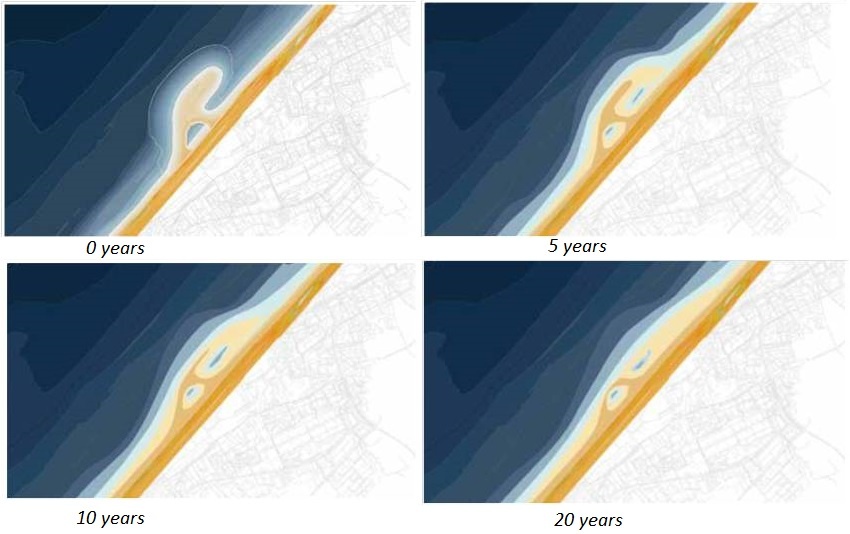Operation and Maintenance
In November 2011 the construction of the Sand Motor was completed. A total amount of 21,5 million m3 of sand had been placed in front of the Delfland coast, with the objectives to provide long-term safety, to create extra space for recreation and natural development and to learn as much as possible from it. Are mega-nourishments a good alternative for smaller-scale periodic nourishments? The first results of the experiment will be assessed 5 years after construction. To this end an extensive monitoring program is in place.
During the first year after construction the Dutch coast was exposed to a number of heavy south-westerly storms. As a consequence, the morphological evolution of the Sand Motor proceeded faster than expected, but the shape developed according to the expectation, with the tip of the initial hook extending northward and bending over to the shore, thus creating a tidal lagoon (see this video ).
In spring 2012, the extension of the Sand Motor’s tip enclosed a lagoon and an alongshore channel through which the lagoon filled and emptied every tide. Worried about the further development of this channel and its effects on beach slopes and swimmer safety, the Province of South Holland, the authority responsible, decided to close it off with rock and create by another feeder channel, more remote from the beach. During the summer, the dynamic coastal processes drastically changed the lay-out of the channels. As swimmer safety was no longer endangered, the majority of the rock was removed again in September 2012.
Strategies
In view of the pilot character of the project an extensive monitoring program was set up concerning the morphological and ecological development of the Sand Motor (RWS, Province Zuid Holland et al. (2013).
Considering that the Sand Motor is meant to redistribute alongshore over the stretch of coast between Hoek van Holland and Scheveningen, additional maintenance on this stretch for the coming 20 years, is expected to be limited (Mulder and Tonnon, 2010).
Monitoring

The time-evolution of the Sand Motor is carefully monitored year-round. The first step was to map the shape of the seabed and the ecosystem before construction. The Sand Motor was monitored during construction and is being monitored after construction, for management and operational purposes and to evaluate whether this innovative method of coastal protection actually works.
The monitoring program focuses on six areas: 1) Weather, waves and currents, 2) Sand distribution, 3) Groundwater table and quality, 4) Flora and fauna, 5) Recreation, and 6) Management (see Infographic Sand Motor Monitoring ).
Early October 2012 a 40 m high Argus-mast has been placed on the Sand Motor. It is equipped with video cameras which will register the changes of the Sand Motor continuously; directly by visual monitoring of the emerged parts, and indirectly by monitoring wave behaviour (propagation, breaking).
The research program is divided into two phases: 2011-2016 and 2016-2021. This program is coordinated jointly by the Ministry of Public Works and EcoShape and is funded partly by the European Union under the European Program for Regional Development (EFRO).
End of life
Eventually the Sand Motor will be redistributed along the coast by wind, waves and currents. It will induce gradual dune formation along a larger stretch of coastline over a period of a few decades, thus contributing to flood safety and dune nature. Since the Sand Motor is a sacrificial coastal maintenance measure, no significant maintenance is foreseen.
